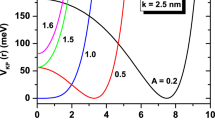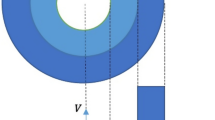Abstract
In this work, we have studied the effects of the number of wells, quantum dot thickness, and dielectric mismatch on binding energy of a single-donor impurity which confined in GaAs constant total effective radius multi-shell quantum dots. We have found an oscillating binding energy when numbers of wells increase. Oscillations of 1s and 2s binding energies have 180° phase difference, while 1s and 3s binding energies oscillate in phase. When outer quantum dot radius R 2 increases, the amplitudes of the oscillations decreases, while by going from 1s to 3s, the amplitudes of the oscillations increase. When ɛ 2/ɛ 0 increases, the impurity binding energy decreases. Finally, we have shown that effect of the dielectric mismatch is larger for systems with smaller outer quantum dot radius R 2.








Similar content being viewed by others
References
Bastard G (1981) Hydrogenic impurity states in a quantum well: a simple model. Phys Rev B 24:4714
Bryant GW (1985) Hydrogenic impurity states in quantum-well wires: shape effects. Phys Rev B 31:7812
Kazaryan EM, Petrosyan LS, Sarkisyan HA (2003) Impurity states in a narrow band gap semiconductor quantum dot with parabolic confinement potential. Phys E 16:174
Li S-S, Xia J-B (2007) Binding energy of a hydrogenic donor impurity in a rectangular parallelepiped-shaped quantum dot: quantum confinement and stark effects. J Appl Phys 101:093716
Liu ZP, Li TK (1985) Hydrogenic impurity states in GaAs-Ga1-xAlx as quantum well structures. J Phys C Solid State Phys 18:691
Movilla JL, Planelles J (2005) Off-centering of hydrogenic impurities in quantum dots. Phys Rev B 71:075319
Niculescu EC (2011) Dielectric mismatch effect on the photoionization cross section and intersublevel transitions in GaAs nanodots. Opt Commun. 284:3298
Porras-Montenegro N, Perez-Merchancano ST (1992) Hydrogenic impurities in GaAs-(Ga, Al) as quantum dots. Phys Rev B 46:9780
Press WH, Teukolsky SA, Vetterling WT, Flanner BP (2007) Numerical recipes, 3rd Edn edn. Cambridge University Press, Cambridge
Shi JM, Peeters FM (1994) Shallow donor impurities in GaAs/Al x Ga1–x As superlattices in a magnetic field. Phys Rev B 50:15182
Sivakami A, Gayathri V (2013) Hydrostatic pressure and temperature dependence of dielectric mismatch effect on the impurity binding energy in a spherical quantum dot. Superlattices Microstruct 58:218
Solaimani M (2014a) Refractive index changes in constant total effective length GaN/AlN multiple quantum well systems under external electric field. Int J Mod Phys B 28:1450204
Solaimani M (2014b) GaN/AlN constant total effective radius multi-wells quantum rings: physical properties under well number variation effects. Solid State Commun 200:66
Solaimani M (2014c) Nonlinear optical absorption of a two electron GaN/AlN constant total effective radius multi-shells quantum rings. J Nonlinear Opt Phys Mater 23:1450049
Solaimani M, Izadifard M, Arabshahi H, Sarkardei MR (2013a) Study of optical non-linear properties of a constant total effective length multiple quantum wells system. J Lumin 134:699
Solaimani M, Izadifard M, Arabshahi H, Sarkardei MR (2013b) Effect of the magnetic field on optical properties of GaN/AlN multiple quantum wells. J Lumin 134:88
Solaimani M, Izadifard M, Arabshahi H, Sarkardei MR (2013c) Magnetic field dependence optical properties of GaN/AlN multiple quantum wells. Optik 124:3194
Zhu JL, Chen X (1994a) Spectrum and binding of an off-center donor in a spherical quantum dot. Phys Rev B 50:4497
Zhu JL, Chen X (1994b) Spectrum and binding of an off-center donor in a spherical quantum dot. Phys Rev B 50:4497
Zhu J-L, Xiong J-J, Gu B-L (1990) Confined electron and hydrogenic donor states in a spherical quantum dot of GaAs-Ga1–x Al x As. Phys Rev B 41:6001
Zhu JL, Zhao JH, Xiong JJ (1994) Dimensionality and potential-shape effects on D0 and D− ground states in quantum dots. Phys Rev B 50:1832
Acknowledgements
We are grateful for the financial support of the Iranian Nanotechnology Initiative Council (INIC) and Qom University of Technology supports.
Author information
Authors and Affiliations
Corresponding author
Rights and permissions
About this article
Cite this article
Solaimani, M., Babayar Razlighi, B. Behavior of Donor Impurity Binding Energy Confined In a GaAs Constant Total Effective Radius Multi-Shell Quantum Dots: Dielectric Mismatch Effects. Iran J Sci Technol Trans Sci 41, 1075–1081 (2017). https://doi.org/10.1007/s40995-017-0341-7
Received:
Accepted:
Published:
Issue Date:
DOI: https://doi.org/10.1007/s40995-017-0341-7




